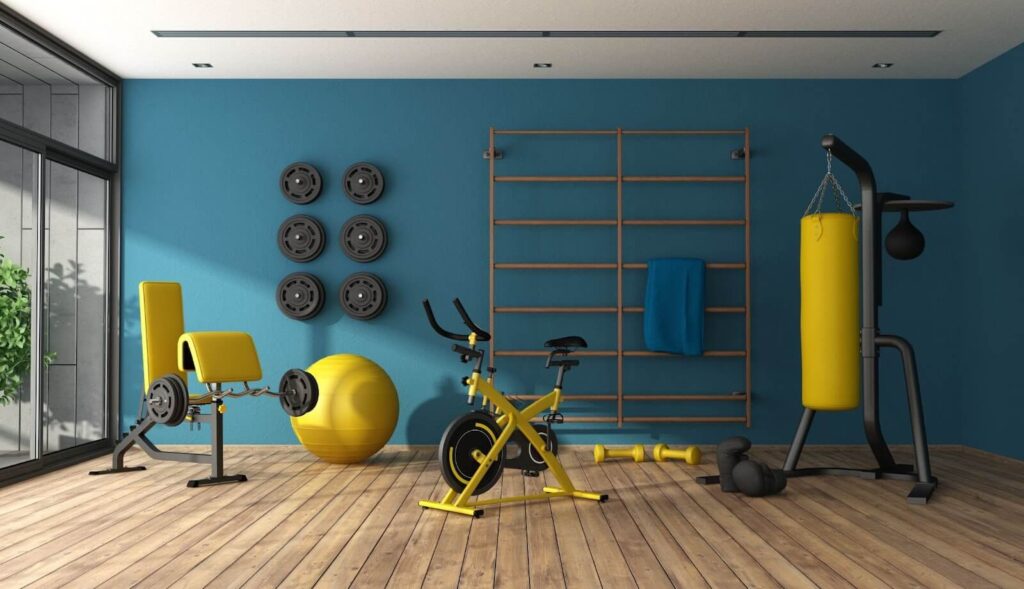Whether it’s because you don’t have enough time or lack the motivation, countless people spend money on a gym membership that they don’t actually utilize.
If you find that you’re one of those people, one way to reduce the money you spend and increase the likelihood of you exercising is by building a home gym. Having a gym space set up in your home is a great way to maintain your health and fitness. While the initial costs to build your space might be a lot, you’ll quickly recoup your money in no time without having to pay for an expensive gym membership.
One of the most important components of your home gym is the flooring. This guide will go over how to choose the flooring for your home gym and the benefits each type can provide.
How to Properly Build a Home Gym
What’s the Best Type of Flooring for a Home Gym?
The type of flooring you choose depends upon what type of exercise you do and what kind of equipment you use. You want your flooring to have the following types of qualities:
-
Impact shock absorption
-
Traction
-
Durability
Without all of those features, you’re at risk of injuring yourself, slipping, or encountering chronic joint and muscle pain.
Rubber Flooring
Rubber flooring is one of the most popular types of gym flooring. It’s a great choice for covering a variety of residential flooring options. It also can support heavy exercise equipment.
Rubber flooring is also popular because of its shock absorbency and durability features. You can purchase rubber flooring in interlocking tiles, mats, or rolls. It comes in different sizes and thicknesses.
Vinyl Flooring
Another option is vinyl flooring. This type of flooring is easy to clean and water-resistant.
If your gym is in your basement or garage, vinyl flooring is a good choice because it’s moisture and mildew-resistant. It’s also very durable and can support the weight of your equipment. However, it’s not as shock absorbent as rubber flooring.
Foam Flooring
Foam flooring is similar to laying out exercise mats on your floor. You can also purchase foam floor tiles, which are portable and easy to install.
Foam flooring is less expensive than rubber, but it’s not as durable. It’s not ideal for super-intense workouts or heavy exercise equipment. However, it’s a great option if you primarily do Pilates and yoga.
Cork Flooring
Cork flooring can support you during intense workouts and has a lot of shock absorbency. It’s a great, eco-friendly option that’s resistant to mildew, fire, and mites. Since cork tends to fade when it’s in direct sunlight, cork flooring is perfect for building a home gym in the garage or basement.
Carpet
You can use carpet tiles or have wall-to-wall carpet put in your home gym. You’ll want to look for commercial-grade and low pile carpet. That’ll provide you with enough stability and traction.
The carpet will also blend seamlessly in with your home’s decor. It can also support the weight of your machines. However, it isn’t as shock absorbent as other options and can trap moisture and sweat.
How to Build a Home Gym
Now that we’ve talked a bit about the flooring types that are great for home gyms, let’s go over the other things you’ll need to consider. Creating a gym in your home doesn’t have to be expensive or difficult when you plan ahead.
1. Pick Your Spot
The first step to getting started on your home gym is finding a spot. This can be in a spare room, garage, basement, or corner of your living room. The most important thing is that you devote this space to your gym and nothing else.
If it’s hard for you to find any space at all, try to clear out an area that’s four feet by eight feet. That’s the standard size of space you need to get started. As your exercise routine grows, you can always make room for a larger space.
2. Purchase Your Equipment
Think about what types of exercise you want to do. For many people, a barbell is the centerpiece of an at-home gym. You’ll also need some plates to add to it.
You can do hundreds of workouts with that combination of gym equipment. You can look for affordable gym equipment on Craigslist, Facebook, or other places where people sell used items.
Your workout routine might be centered around yoga or perhaps walking. Purchase whatever you need to fit your exercise routine. Start small, as you can add in more items as you grow your gym.
3. Add Your Flooring
We’ve already discussed all the different flooring options you can have in your gym. This is when you should contact a professional like Ozburn-Hessey to help you with your gym flooring installation. We can provide you with expert recommendations and installation services.
4. Start Working Out
Start off by working out at least two days a week in your home gym. You’ll learn how to create a workout routine that fits your lifestyle and schedule. Some people prefer getting up early to get their workout out of the way while others like to do it when they get home from work.
Whatever your preference is, it’ll be easy for you to head to your home gym when you’re ready to work out. You won’t have to wait your turn at certain pieces of equipment.
Connect With Ozburn-Hessey When Building a Home Gym
Home gym flooring is an essential part when building a home gym, but it can get overwhelming. If you’ve never installed flooring before, there are a variety of things that can go awry. That’s why you should trust the flooring professionals at Ozburn-Hessey to help you bring your home gym to fruition.
Contact us today to learn about our flooring installation services.




